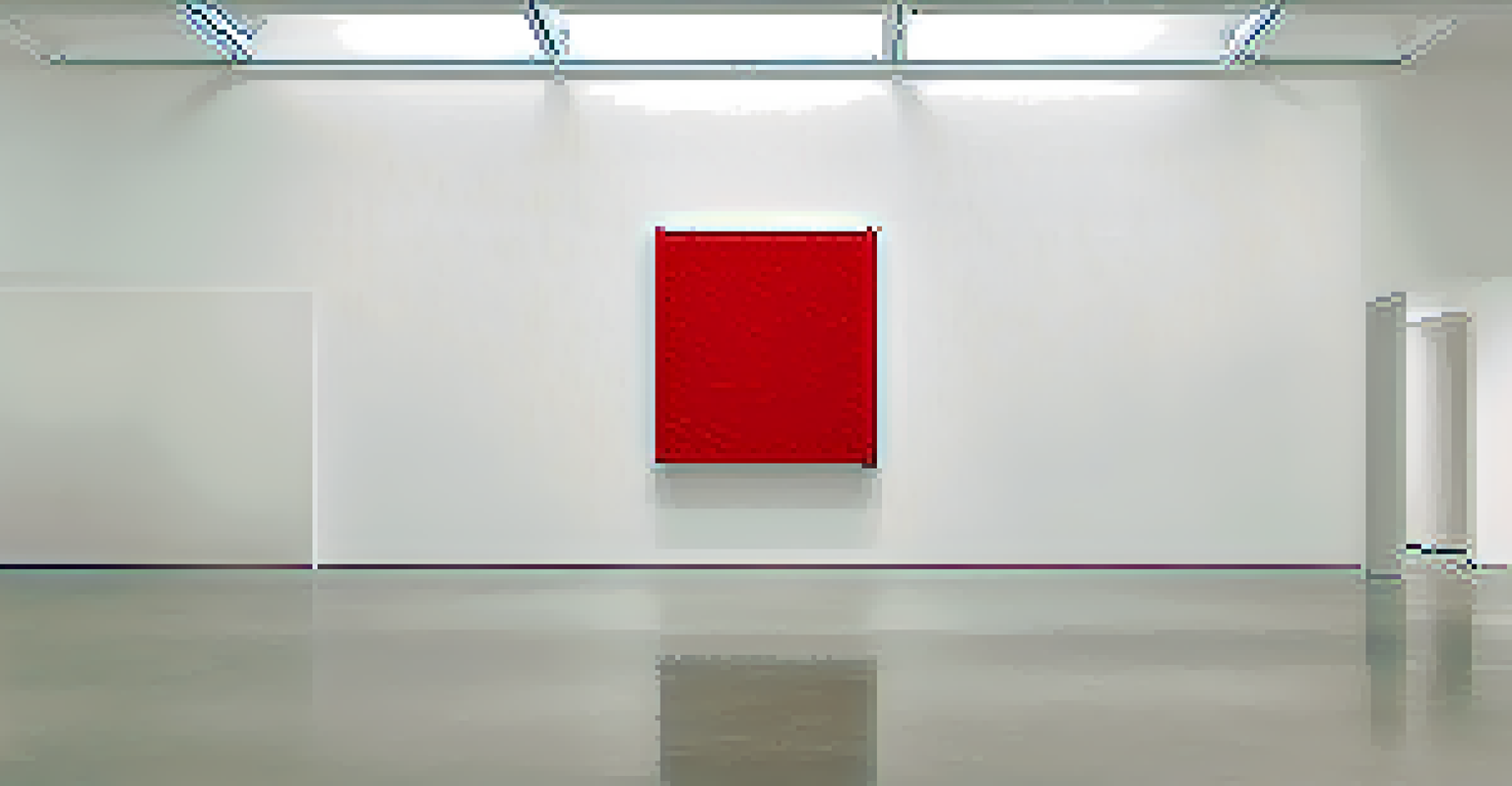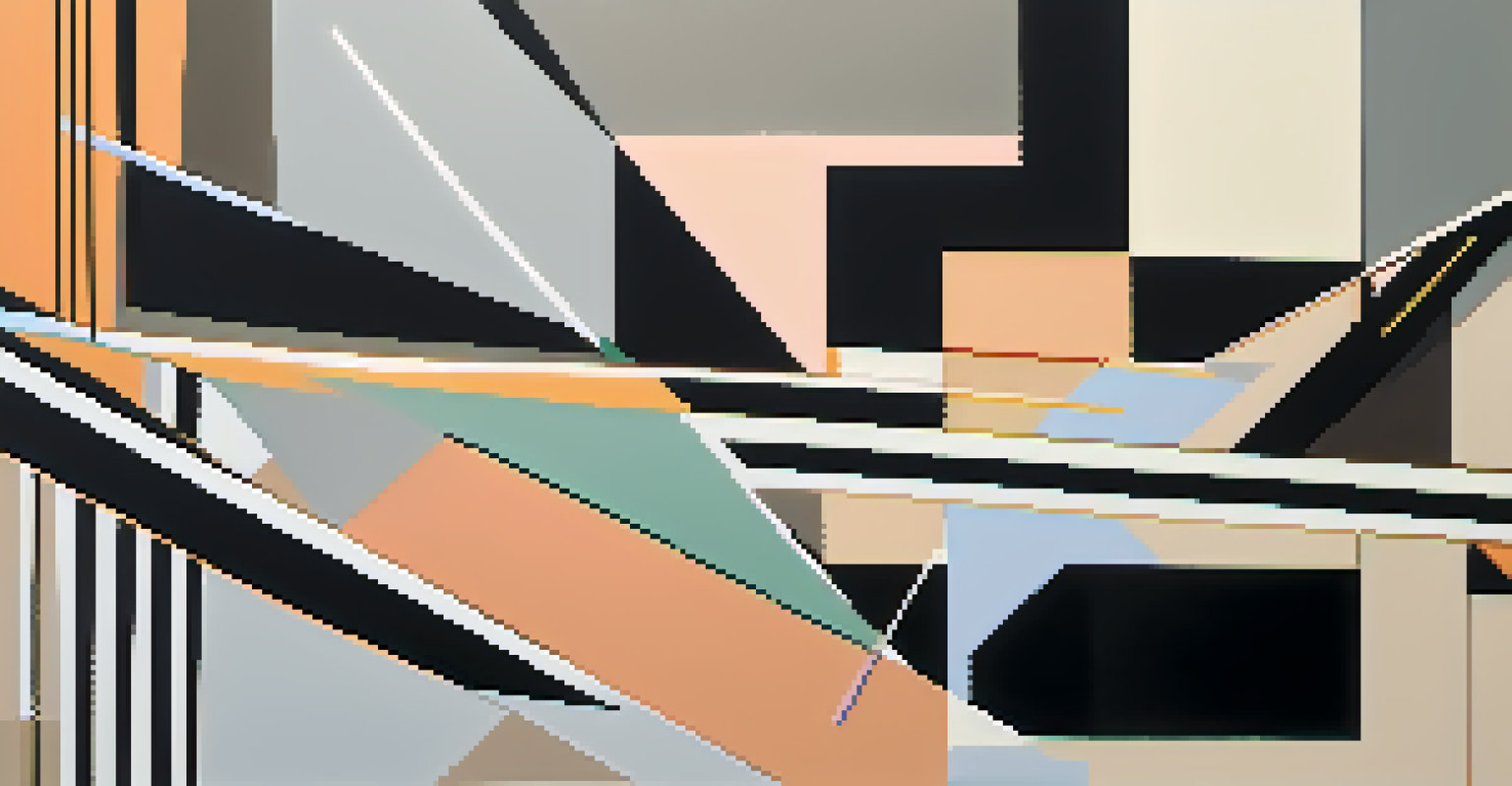Contrast and Harmony: Key Elements in Minimalist Art

Understanding Minimalist Art: A Brief Overview
Minimalist art is a movement that emphasizes simplicity and clarity. By stripping away excess elements, artists focus on the essence of their work. This approach invites viewers to engage with the piece on a deeper level, often evoking emotional responses with minimal distractions.
Simplicity is the ultimate sophistication.
At its core, minimalist art challenges traditional notions of complexity in art. Instead of overwhelming viewers with details, it presents a refined visual language. Artists like Donald Judd and Agnes Martin exemplify this by using basic shapes and limited color palettes to convey profound ideas.
The beauty of minimalist art lies in its ability to create a sense of space and tranquility. By removing the clutter, artists allow the audience to experience the artwork in a more intimate way. This simplicity not only speaks to aesthetics but also to the philosophies of modern living.
The Role of Contrast in Minimalist Art
Contrast plays a pivotal role in minimalist art, drawing attention to key elements. By juxtaposing light and dark, or smooth and rough textures, artists create visual interest that captivates the viewer. This deliberate use of contrast can evoke strong emotions and provoke thought.

For instance, a bright red square against a stark white background immediately grabs your attention. This bold contrast not only highlights the red square but also invites viewers to explore its significance. The simplicity of the composition allows for a deeper reflection on the relationship between the colors.
Simplicity Evokes Deep Engagement
Minimalist art strips away excess, inviting viewers to connect with the essence of the piece on a more profound emotional level.
In minimalist art, contrast is not just about visual appeal; it often carries conceptual weight. It can symbolize conflict, harmony, or even balance in life. Through this interplay of opposites, artists encourage viewers to contemplate the complexities hidden within simplicity.
Harmony: The Soul of Minimalist Art
While contrast draws attention, harmony in minimalist art creates a sense of unity. It’s the seamless blending of elements that fosters a feeling of peace and balance. Artists achieve harmony through careful arrangement, color coordination, and proportion.
Less is more.
Imagine a serene landscape painting where soft hues of blue and green blend effortlessly. This harmonious composition invites the viewer to relax and reflect, illustrating how minimalism can evoke tranquility. The absence of chaos allows for a meditative experience.
In minimalist art, harmony is not about uniformity; it's about creating a cohesive experience. Each element, no matter how simple, contributes to the overall aesthetic. This interconnectedness embodies the minimalist ethos of finding beauty in simplicity.
The Balance of Contrast and Harmony
The interplay between contrast and harmony is what gives minimalist art its unique character. These elements work together to create depth and intrigue while maintaining simplicity. A successful minimalist piece balances these two forces, drawing the viewer in without overwhelming them.
Consider a piece that features sharp, contrasting lines complemented by soft, harmonious colors. This combination not only captures attention but also soothes the senses, creating a dynamic yet calming effect. Such balance allows for a multi-layered experience in what appears to be a simple composition.
Contrast and Harmony Create Balance
The interplay of contrast and harmony in minimalist art fosters depth and intrigue while maintaining a sense of unity and tranquility.
Ultimately, the balance between contrast and harmony reflects the complexities of life itself. Just as we navigate opposites in our daily experiences, minimalist art invites us to explore the beauty found in that balance. It’s a reminder that less can indeed be more, both in art and in life.
Examples of Contrast and Harmony in Minimalist Art
Many renowned minimalist artists effectively demonstrate the balance of contrast and harmony. For instance, Ellsworth Kelly’s vibrant color fields showcase striking contrasts while maintaining a sense of harmony in their arrangement. The simplicity of his forms allows viewers to appreciate the beauty of each hue.
Another example is the work of Yayoi Kusama, whose polka-dot patterns create a playful contrast against empty spaces. Her ability to blend chaotic elements with serene backgrounds exemplifies the harmony that characterizes her installations. This unique approach captures the viewer's imagination and invites personal interpretation.
These artists highlight how the principles of contrast and harmony are not only essential to minimalist art but also resonate with a broader audience. Their works challenge us to see beyond the surface, encouraging deeper engagement with art and its meanings.
The Emotional Impact of Minimalist Art
Minimalist art often evokes a range of emotions, thanks to the interplay of contrast and harmony. The simplicity of these works allows viewers to project their feelings, creating a personal connection. This emotional resonance can be both introspective and transformative.
For instance, walking into a minimalist space adorned with subtle contrasts can elicit feelings of calmness and clarity. The absence of clutter fosters a serene atmosphere, encouraging reflection and mindfulness. In this way, minimalist art serves as a sanctuary from the chaos of everyday life.
Emotional Resonance of Minimalism
Through its simplicity, minimalist art allows for personal interpretation, creating emotional connections that can be introspective and transformative.
Moreover, the emotional impact of minimalist art often stems from its ability to tell a story through minimal means. Each element, whether contrasting or harmonious, plays a role in conveying a narrative. This subtlety invites viewers to engage, think, and feel, making the experience uniquely personal.
Conclusion: The Lasting Appeal of Minimalism
The principles of contrast and harmony are fundamental to the enduring appeal of minimalist art. By mastering these elements, artists create works that resonate with audiences on multiple levels. Minimalism challenges us to appreciate the beauty in simplicity while exploring deeper meanings.
As we navigate a world filled with distractions, minimalist art offers a refreshing perspective. It encourages us to slow down, reflect, and find beauty in the essential. This timeless quality ensures that minimalist art continues to inspire and provoke thought across generations.

In conclusion, understanding how contrast and harmony function within minimalist art enriches our appreciation of this movement. It invites us to explore our own interpretations while celebrating the power of simplicity. Minimalism, with its elegant balance, proves that less can indeed be more.